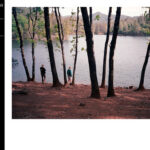Richard Avedon: “The Photographer of the Twentieth Century”
*Photo by: 2ou3chooses.tumblr.com “Richard Avedon Photographing Sophia Loren, 1966”
Today were gonna talk about one of the most important person on the world of photography and fashion. In the beginning photography was only use as a way to communicate fashion, but the way Avedon portrayed his images was so revealing that changed the industry and influence creations. He developed an innovative, elegant and classic style but with a different point of view; he mixed the street photography with the fashion photography but with an “emotional” feel and gave personality to the models.
Richard Avedon changed the schemes and defined our image of beauty, elegance and culture. He captured the most important features and moments of the century and he also gave voice to many people without fame, with his photographs of the civil rights movement of the southern United States, from protesters of the Vietnam War or the fall of the Berlin Wall. These are only a small part of the treasure that he left for our society.
Here I found some interesting books written about or mentioned Richard Avedon as one of the most important photographers of all time.
- On the book by Richard Bolton “In the American East: Richard Avedon Incorporated” (1988), Bolton says “In 1979 Avedon began, what would become a five year project photographing the marginal and dispossessed citizens of the west, “the men and the women who work at hard uncelebrated jobs, the people who are often ignored and overlooked”. In this project, economic obsolescence is photographed by someone who well understands the logic of obsolescence of our society.
- The book “Image Ethics in the Digital Age” has a chapter that talks about Avedon’s photography written by Matthew Soar (2003), and says: “The examples discussed here relate to photographic images or genres familiar to one arena (galleries, museums, books) and then transfer to another (advertising). Richard Avedon is often known as a commercial photographer of fashion and celebrities who, periodically, often produces “art” images”.
- Richard Avedon is often mentioned in books about history of photography and Face of Fashion (2007) is no exemption. On this book the authors says: “The essays by Susan Bright and Vince Aletti offer a historical context to reflect society’s fascination with images of the famous, how these photographers’ works have developed from the legacy left by Cecil Beaton, Irving Penn, Richard Avedon and others. “
- Nancy Hall Duncan writes a deep essay about the history of Fashion Photography, from the photographers, models, to the success through history. Hall says: “The charming ease of Richard Avedon’s fashion style of the 1950s was perfectly suited to a war-weary society. In this decade, Avedon staged his models as glamorous but “real” girls whose carefree exuberance was both sophisticated and appealing. Each was an actress of sorts, creating both a fashion look and a dialogue of emotions. The charming ease of Richard Avedon’s fashion style of the 1950s was perfectly suited to a war-weary society. In this decade, Avedon staged his models as glamorous but “real” girls whose carefree exuberance was both sophisticated and appealing. Each was an actress of sorts, creating both a fashion look and a dialogue of emotions”.
- In the book Fashion Forward (2011) Jacque Lynn Foltyn says in a chapter about dead in the fashion photography: “Fashion-wise, the precursors of corpse chic are the photographers Guy Bourdin and Richard Avedon. In the USA, Richard Avedon’s audacious fable, ‘In memory of the late Mr. and Mrs. Comfort,’ appeared in the Nov 6, 1995 issue of The New Yorker, and featured a skeleton modelling clothing alongside the supermodel Nadja Auermann”.
- Michael R. Peres in his book The Concise Focal Encyclopedia of Photography (2008) talk about Avedon style of photography as: “Richard Avedon quickly became recognize for his genius photographic dramatist. Avedon presented the model as pretty but, not glamorous”.
- On the article: Radical Chic: That Party at Lenny’s (1970) Tom Wolfe says, “Now Avedon was putting together a book about the Movement. He went to Chicago for the trial of The Eight and set up a studio in a hotel near the courthouse to the portraits of the celebrities and activists who testified at the trial or watched it or circled around in on one way or another”.
- Leo Vince wrote an article about some recordings of Avedon, named Listening to Avedon. on it the author says: “Avedon discusses photographic truth, authorship and meaning not so much as parts of a theoretical discussion but as parts of himself discovered through the process of photographing others”.
- The book, Seeing Richard Avedon (2008) by Erik Arthur Palmer, the author describes the photographer as: ” Working primarily in the genres of fashion, celebrity and fine art portraiture, Avedon pursued a career that extended across six decades, and he participated in the invention and refinement of many of the norms of contemporary media photography”.
- On the thesis Richard Avedon, the Khmer Rouge & the Ideological Power of Portraiture by Erik Palmer the author says, that Avedon himself “proposed that his work intended to examine the deepest and most subtle levels of interpersonal communication through photographic portraiture, and to create objects that reveal narratives embedded in his encounters with the people he photographs”.
Continuing my research through the web I found the top five websites, articles or blogs that honor the amazing Richard Avedon.
- Avedon Foundation.org this webpage is dedicated 100% to Avedon’s work, they even have an app and the mission of this foundation is to maintain alive the legacy of the photographer. Is super friendly and up to date, on a scale of 0 to 3 I gave it a 3+.
- The Telegraph.co.uk here I found an interesting article named “Richard Avedon: The Photographer that made Dior” by Lisa Armstrong. It talked about that some of the most memorable photographs of Dior were taken by Avedon and how those photographs took the designer to another level of success. This article has a lot of relevance to Avedon’s career and since is from The Telegraph website one of England most famous newspaper it has a lot of credibility, I gave it a 2.5.
- Harpers Bazaar.com I found an amazing article named: “Avedon’s Women” by Joan Juliet Buck; since Richard Avedon worked for so long for Harpers Bazaar Magazine and create some of the most iconic covers for the magazine. In this article the author writes about some of the muses of Avedon and how they inspire him to create those iconic images. It’s not a recent article but it has a lot of information and it’s really good I gave it a 3.
- Time Magazine.com made this article called “All-Time 100 Fashion Icons” by Alexander Ho, they named Richard Avedon as one of the most influential fashion icons of all time. It is not a recent article but since it come from Time Magazine is definitely a respected and well written story and I gave a 2.5.
- Vogue.com Last but not least I found this extraordinary article written by Alex Frank called “On Richard Avedon: Truman Capote’s 1959 Essay on the Master Photographer”, this article speaks about a series of essays that Capote wrote about Richard Avedon based upon his photographs and iconic images. These series of essays were made a book called “Observations” by Richard Avedon and Truman Capote. I really recommend everyone to read at least this article, is somewhat recent and gave it 3.
Well my lovely people I hope I have been to some of you a helpful fairy and has sparkle a little of my research to some of you guys about this extraordinary photographer called as you already know, Richard Avedon. He is truly a legend not only to the fashion world but photography as well; I admired his work and I recommend that everyone should check his beautiful and exquisite images.
As he once said: “I know that the accident of my being a photographer has made my life possible”.
Richard Avedon

*Photo by: Sam Shaw “Richard Avedon and Marilyn Monroe, 1957”


